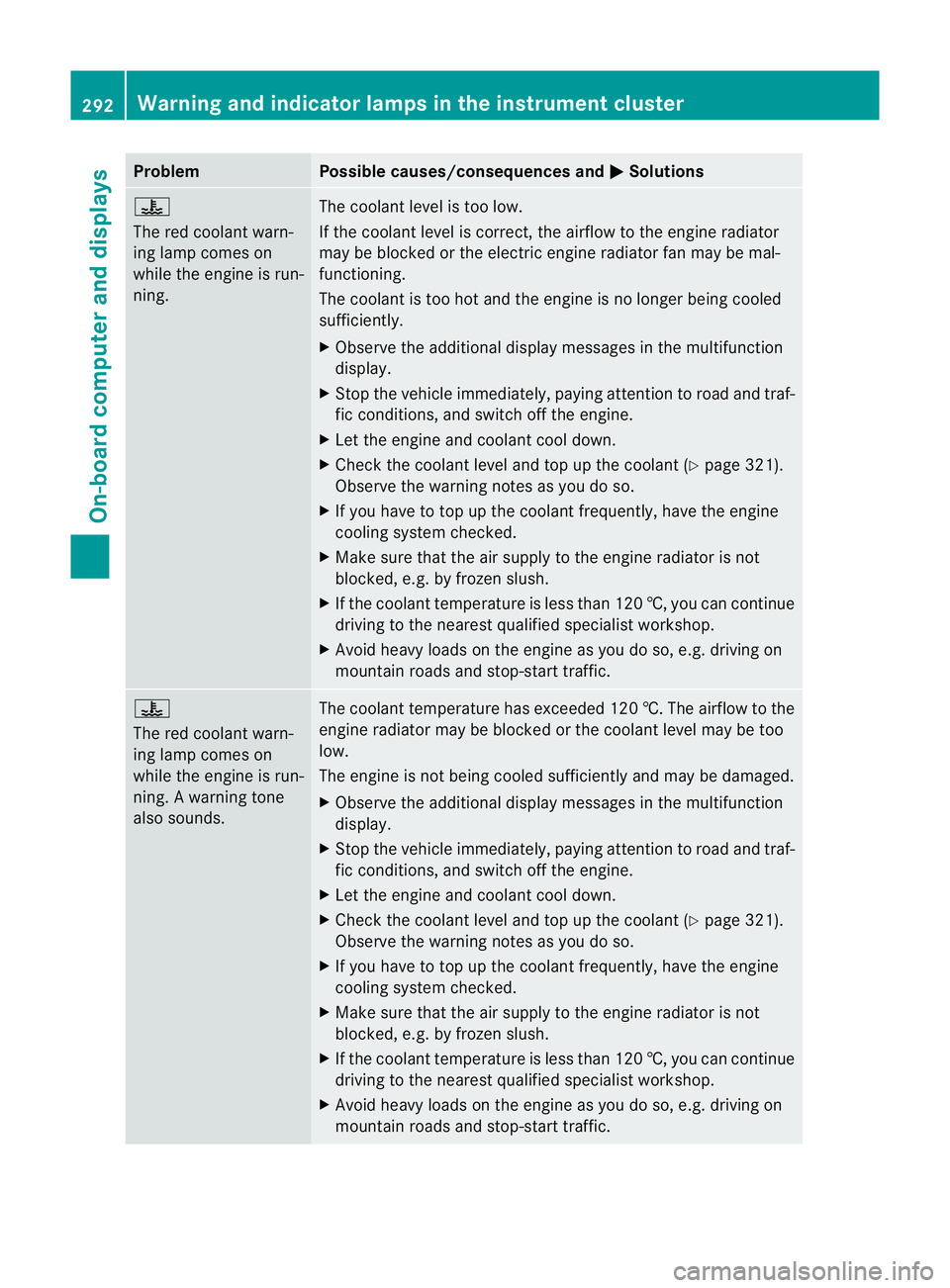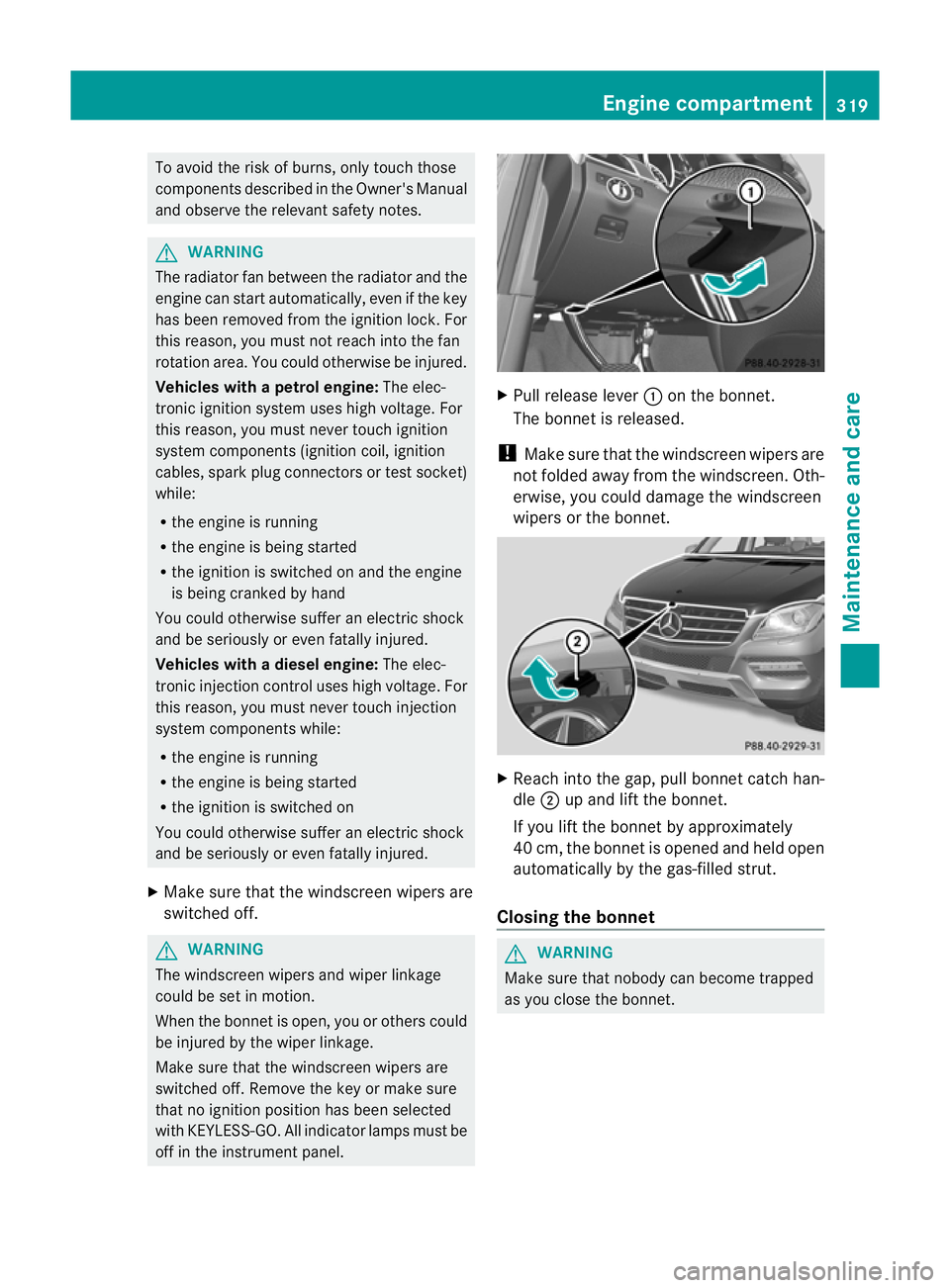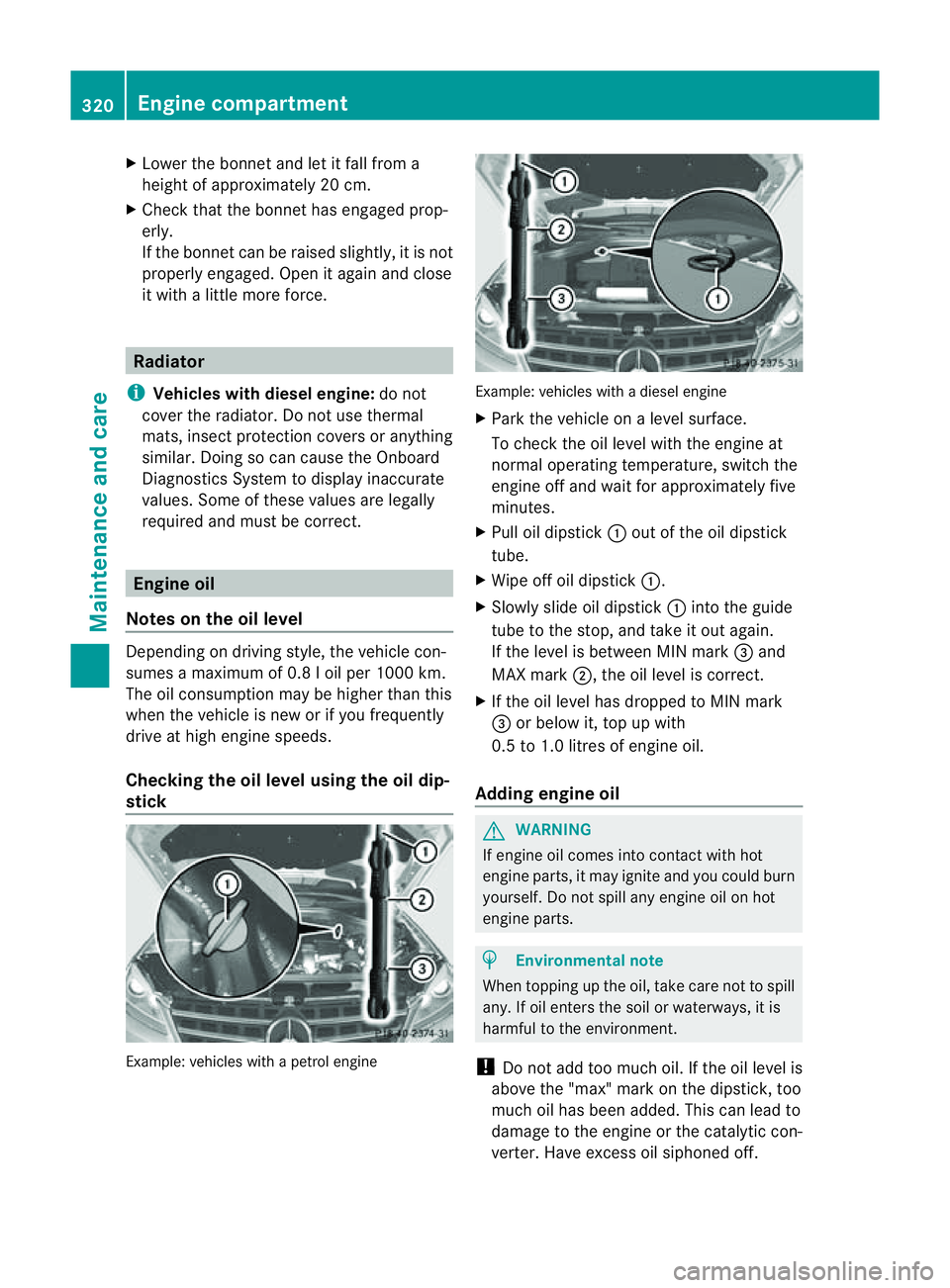2011 MERCEDES-BENZ M-CLASS SUV radiator
[x] Cancel search: radiatorPage 15 of 389

Headlamps
Misting up ...................................... 111
Topping up the cle aning system ....321
se eA utomati cheadlamp mode
Hea drestraints
Adjusting ......................................... 94
Adjusting (e lectrically )..................... 95
Adjusting (manually )........................ 94
Adjusting (re ar)................................ 95
Fitting/removing (re ar).................... 96
Heati ng
se eC limate control
High-pressure clean ers.................... 325
Hill star tassist .................................. 141
HOLD function Display message ............................ 272
Function/notes ............................. 187I
Immobili ser.......................................... 68
Ind icator and warn ingl amps
Co olan t.......................................... 291
DISTRONI CPLUS ........................... 293
Engine di agnostics ......................... 290
Fue ltank ........................................ 291
Indicator lamps
Display message ............................ 263
se eW arning and indicator lamps
Indicators
see Turn signals
Insec tprotection on the radiator ....320
Instrument cluster Overview .......................................... 30
Setting s......................................... 246
Warn inga nd indicator lamps ...........32
Instrument cluste rlighting ................ 30
Instrument li ghting
see Instrument cluster lighting
Intelligen tLight System
Activating/deactivatin g................. 247
Display message ............................ 264
Setting the di pped-beam head-
lamps for driving on the right/left .247
Int erior lighting ................................. 112
Automatic control sy stem .............. 112
Del ayed swit ch-off (on-bo ard
computer) ...................................... 249Emergency lighting
........................112
Manual control ............................... 112
Overview ........................................ 112
Reading lamp ................................. 112
Setting the ambient lighting
bri ghtness (on-bo ardc omputer ).... 248
Setting the ambient lighting col-
ou r(on-board computer) ...... .......... 248
Interior motio nsensor ........................ 69
IS OFIX child seat securing system ....53 J
Jack Storage locatio n............................ 333
Using ............................................. 339
Jump startin g(engine) ...................... 348 K
Key Changing the battery ....................... 75
Ch ecking the battery ....................... 74
Convenience closing feat ure. ........... 84
Convenience opening feat ure. ......... 84
Display message ............................ 282
Doo rcentral locking/unlocking .......72
Emergency key el ement ...... ............. 74
Loss ................................................. 76
Modifying the programming .............73
Positions (i gnition lock) ................. 139
Pro blem (malfunction) ..................... 76
Starting the engine ........................140
KEYLES S-GO
Convenience closing ........................85
Display message ............................ 282
Locking ............................................ 73
Start/Sto pbutton ...... .................... 139
Starting the engine ........................140
Unlockin g......................................... 73
Ke yp ositions
Key ................................................ 139
KEYLESS GO .................................. 139
Kickdown
Driving tip s.................................... 148
Manual drive program ....................151
Kneebag ............................................... 4412
Index
Page 148 of 389

Problem Possible causes/consequences and
M Solutions
Vehicles with
apetrol
engine:
The engine is not run-
ning smoothly and is
misfiring. There is
amalfunction in the engine electronics or in amechanical
componen tofthe engin emanagement system.
X Only depress the accelerator pedal slightly.
X Have the cause rectified immediately at aqualified specialist
workshop, e.g. aMercedes-Benz Servic eCentre.
Otherwise, non-combusted fuel may get into the catalytic con-
verter and damage it. The coolan
ttempera-
tur ed isplay is showing
more than 120 †. The
coolant warnin glamp
may also be on and a
warning tone may
sound. The coolant level is too low. The coolant is too hot and the engine
is no longer being cooled sufficiently.
X Stop as soon as possible and allow the engine and the coolant
to cool down.
X Check the coolant level (Y page 321). Observe the warning
notes as you do so and top up the coolant if necessary. If the coolant level is correct
,the radiator fa nmay be faulty. The
coolant is too hot and the engine is no longer being cooled suffi-
ciently.
X At coolant temperatures under 120 †, drive on to the nearest
qualified specialis tworkshop, e.g. to aMercedes-Benz Service
Centre.
X Avoid heavy loads on the engine as you do so, e.g. driving on
mountain roads and stop-start traffic. Automa
tict ransmission Important safety notes
G
WARNING
The movement of the pedal smust not be
impaired in any way. Do not keep any objects
in the driver's footwell. Make sure that floor-
mats or carpets are correctly secured and
that there is sufficient clearance for the ped-
als.
Do not place several floormats on top of one
another. G
WARNING
Do not change down for additional engine
braking on aslippery road surface. This could
cause the drive wheels to lose their grip and
the vehicle could skid. This could cause you to lose control of your vehicle and cause an
accident. DIRECT SELECT lever
Overview of transmissio npositions The DIRECT SELECT leve
risonthe right of the
steering column. Automa
tict ran smission
145Drivingand park ing Z
Page 216 of 389

G
WARNING
Active Blind Spo tAssist monitor scertain
areas in the immediate vicinity of your vehicle.
Vehicles that approach and drive past at high
speeds are not detected. No visual nor audi-
ble warnings are emitted and the syste mdoes
not brake the vehicle to cor rect your course.
If the lane sare very wide, it may not be pos-
sibl etom onitor the complet ewidth of the
neighbourin glane. For this reason, vehicles in
the nex tlane may not be detected, especially
if they are driving in astaggered formation.
Thi sm ay be the case if vehicles are driving at
the edge of their lane that is furthest away
from your vehicle.
Always pay attention to traffic conditions and
your surroundings. Otherwise, you may fail to
recognise dangers in time, cause an accident
and injure yourself and others.
If the lanes are narrow, vehicles driving in the
lane beyond the lane nex ttoyour vehicle may
be indicated, especially if the vehicles ar enot
drivin ginthe middle of their lane. This may
be the case if ther eare vehicles at th eedge
of their lane nearest your vehicle. Due to the nature of the system:
R
warnings may be issued in error when driv-
ing close to crash barriers or simila rsolid
lane borders.
R warnings ma ybeinterrupted whe ndriving
alongsid elong vehicles, such as lorries, for
ap rolonged time.
Tw oA ctive Blind Spo tAssist radar sensors
ar ei ntegrated into the front and rear bumpers
respectively. An additional radar sensor is
locate dbehind the cover in the radiator grille.
Make sure that the bumper sare free of dirt,
ice or slus haround th esensors. The rear sen-
sors must not be covered, e.g. by bicycle
racks or overhanging loads. Followin ga
severe impac torinthe even tofdamage to
the bumpers, have the function of the radar
sensors checked at aqualified specialist
workshop. Blind Spot Assis tmay otherwise
not work properly.
Indicator and warning display :
Yellow indicator lamp/red warning lamp
When Active Blind Spot Assis tisa ctivated,
indicator lamp :in the exte rior mirror slights
up in yellow at speeds of up to 30 km/h. At
speeds above 30 km/h, the indicator lamp
goes out and Active Blind Spot Assist is
operational.
If av ehicle is detected within the monitoring
range of Blin dSpot Assist at speeds above
30 km/h, warning lamp :on the corre-
sponding side lights up red. This warning is
always emit tedw hen avehicle enter sthe
blin dspot moni toring range from behind or Drivin
gsystems
213Drivingand park ing Z
Page 263 of 389

Displa
ymessages Possible causes/consequences and
M Solutions
PR
E-SAFE Functions cur‐
rently limited See
Owner'
sManual G
Risk of accident
PRE-SAFE ®
Brake is tempora rily inoperative if:
R theD ISTR ONIC PLU Scove rint he ra diatorgrille is di rty.
R the sensor sinthebumpers are dirty.
R itsf unction is impaire ddue to heav yrain or snow.
R ther adar sensor system is temporarily inoperative, e.g. due to
elect romagnetic radiatio nemitted by nearby TV or radio sta-
tions or other source sofelectromagnetic radiation.
R the system is outside the operatin gtemperatur erange.
R the on-board voltage is too low.
PRE-SAFE ®
Brak eiso perational again and the display message
disappears if:
R the dirt (e.g. slush) drops away while the vehicle is in motion.
R the system detects that the sensor sare full yavailable again.
R thes ystem is within the operatin gtemperatur erange.
If the display message continues to be displayed:
X Clean the DISTRONIC PLUS cover in the radiator grille
(Y page 327).
X Clean the bumpers (Y page 327).
X Restart the engine.
X Wait until the batter yissufficiently charged. PRE-SA
FE Functions limited
See Owner's Manual G
Ris
kofa ccident
PRE-SAFE ®
Brak eisf aulty. BA SPLUS or th edistance warnin gsig-
nal may also have failed.
X Visit aqualified specialist workshop. ü If the symbo
lappears in the multifunction display, aseat belt
tongue has been clipped int oarear seat belt buckle.
For further information on the status indicator for the rear seat
belts: (Y page 49). ý G
Risk of inju
ry
If th esymbol appears in the multifunction display, aseat belt
tongue has not been clipped int oarear seat belt buckle.
X If necessary, ask the occupants in the rear to fasten their seat
belts.
For further information on the status indicator for the rear seat
belts: (Y page 49). 260
Display messagesOn-boar
dcomputer and displays
Page 279 of 389

Displa
ymessages Possible causes/consequences and
M Solutions
DI
STRONIC PLUS currently unavail‐
abl
eS ee Owner's Manual DISTRONIC is deactivated and tempora
rily inoperative. Possible
causes:
R theD ISTR ONIC PLU Scove rint he ra diatorgrille is di rty.
R function is impaire ddue to heav yrain or snow.
R thes ensor sinthebumpers are dirty.
R ther adar sensor system is temporarily inoperative, e.g. due to
elect romagnetic radiatio nemitted by nearby TV or radio sta-
tions or other source sofelectromagnetic radiation.
R the system is outside the operatin gtemperatur erange.
R the on-board voltage is too low.
Aw arning ton ealso sounds.
If th edisplay message does no tdisappear:
X Pull over and stop the vehicle safely as soon as possible, paying
attention to road and traffic conditions.
X Apply the electric parking brake.
X Clean the DISTRONIC PLU Scover in the radiator grille
(Y page 32 7).
X Clean the bumper s(Ypage 32 7).
X Restart the engine.
If the system detects that the sensors are fully operational, the
displa ymessage disappears.
DI ST RONIC is operational again. DISTRONIC PLUS
inoperative DISTRONIC PLUS is faulty. BAS PLUS and PRE-SAFE
®
Brake may
also have failed.
Aw arning ton ealso sounds.
X Visi taq ualifieds pecialist workshop. DISTRONI
CPLUS override Yo
uh ave depressed the accelerator pedal. DISTRONIC PLUS is no
longer controlling the spee dofthe vehicle.
X Take your foot off the accelerator pedal. DISTRONI
CPLUS --- km/h An activation conditio
nfor DI STRONIC PLUS is not fulfilled.
X Check the activation conditions for DISTRONIC PLUS
(Y page 174). DISTRONIC PLUS and
SPEEDTRONIC
inoperative DISTRONIC PLUS and SPEEDTRONIC are faulty.
Awarning tone
also sounds.
X Visit aqualified specialist workshop. 276
Display messagesOn-board computer and displays
Page 295 of 389

Problem Possible causes/consequences and
M Solutions
?
The red coolant warn-
ing lam
pcomes on
while the engin eisrun-
ning. The coolant level is too low.
If the coolant level is correct, the airflow to the engine radiator
may be blocked or the electric engine radiator fan may be mal-
functioning.
The coolant is too hot and the engine is no longer being cooled
sufficiently.
X Observe the additional display messages in the multifunction
display.
X Stop the vehicle immediately, paying attention to road and traf-
fic conditions, and switch off the engine.
X Let the engine and coolant cool down.
X Check the coolant level and top up the coolant (Y page 321).
Observe the warning notes as you do so.
X If you have to top up the coolant frequently, have the engine
cooling system checked.
X Make sure that the air suppl ytot he engin eradiator is not
blocked, e.g. by frozen slush.
X If the coolant temperature is less than 120 †, you can continue
driving to the nearest qualified specialis tworkshop.
X Avoid heav yloads on the engin easyou do so, e.g. driving on
mountain roads and stop-star ttraffic. ?
Th
er ed coolan twarn-
ing lamp comes on
while the engine is run-
ning. Awarning tone
also sounds. The coolant temperature has exceeded 120 †. The airflow to the
engine radiator may be blocked or the coolant level may be too
low.
The engine is not being cooled sufficiently and may be damaged.
X Observe the additional display message sint he multifunc tion
display.
X Stop the vehicle immediately, paying attention to roa dand traf-
fic conditions, and switch off the engine.
X Let the engine and coolant cool down.
X Check the coolant level and top up the coolant (Y page321).
Observe the warning notes as you do so.
X If you have to top up the coolan tfrequently, have th eengine
cooling system checked.
X Make sure that the air supply to the engine radiato risnot
blocked, e.g. by frozen slush.
X If the coolant temperatur eisless than 12 0†,you can con tinue
driving to the neares tqualified specialist workshop.
X Avoid heavy loads on the engine as you do so, e.g. driving on
mountain roads and stop-s tart traffic. 292
Warning and indicator lamps in the instrument clusterOn-boar
dcomputer and displays
Page 322 of 389

To avoi
dthe risk of burns, only touc hthose
component sdescribed in the Owner's Manual
and observ ethe relevant safety notes. G
WARNING
The radiator fa nbetween the radiator and the
engine can star tautomatically, even if the key
has been removed from the ignition lock. For
this reason, you must not reach into the fan
rotation area. You could otherwis ebeinjured.
Vehicles with apetrol engine: The elec-
tronic ignition system uses high voltage. For
this reason ,you must never touc hignition
system component s(ignition coil, ignition
cables, spark plug connectors or test socket)
while:
R the engine is running
R the engine is being started
R the ignition is switched on and the engine
is being cranked by hand
You could otherwise suffer an electric shock
and be seriously or even fatally injured.
Vehicles with adiesel engine: The elec-
tronic injection control uses high voltage. For
this reason ,you must never touc hinjection
system components while:
R the engi neis running
R the engin eisbeing started
R the ignition is switched on
You could otherwise suffer an electric shock
and be seriously or even fatally injured.
X Make sure that the windscreen wipers are
switched off. G
WAR
NING
The winds creen wipers and wiper linkage
could be set in motion.
When the bonnet is open, you or others could
be injured by the wiper linkage.
Make sure that the windscreen wipers are
switched off .Remov ethe key or make sure
that no ignition position has been selected
with KEYLESS-GO. All indi cator lamps must be
off in the instrumen tpanel. X
Pull release lever :on the bonnet.
The bonnet is released.
! Make sure that the windscreen wipers are
not folded away from the windscreen. Oth-
er wise ,you could damage the windscreen
wipers or the bonnet. X
Reach into the gap, pull bonnet catc hhan-
dle ;up and lift the bonnet.
If yo uliftt he bonnet by approximat ely
40 cm, the bonne tisopeneda nd held open
automaticall ybythe gas-f illeds trut.
Closin gthe bonnet G
WARNING
Make sure tha tnobody can becom etrapped
as you close th ebonnet. Engine compa
rtment
319Maintena nceand care Z
Page 323 of 389

X
Lower th ebonnet and let it fal lfrom a
heig ht of approx imately 20 cm.
X Check that the bonnet has engaged prop-
erly.
If the bonnet can be raised slightly, it is not
properly engaged. Open it again and close
it with alittle more force. Radiator
i Vehicles with diesel engine: do not
cover the radiator .Don ot use thermal
mats, insec tprotectio ncover sora nything
similar. Doing so can cause the Onboard
Diagnosti csSystem to display inaccurate
values .Some of these values ar elegally
required and must be cor rect. Engine oil
Notes on the oil level Depending on driving style, the vehicle con-
sume samaximum of 0.8 loil per 100 0km.
Th eo il consumption may be higher than this
when the vehicle is new or if you frequently
drive at high engin espeeds.
Checking the oil level using the oil dip-
stick Example: vehicles with
apetro lengine Example: vehicle
swithadiesel engine
X Park the vehicle on alevel surface.
To chec kthe oil level with the engin eat
normal operating temperature, switch the
engine off and wait for approximately five
minutes.
X Pull oil dipstick :out of the oil dipstick
tube.
X Wip eoff oi ldipstick :.
X Slowly slide oil dipstick :into the guide
tube to the stop, and take it out again.
If the level is between MIN mark =and
MAX mark ;,the oil level is correc t.
X If th eoil level has dropped to MIN mark
= or below it, top up with
0.5 to 1.0 litres of engine oil.
Adding engine oil G
WARNING
If engine oil comes into contact with hot
engine parts, it may ignite and you could burn
yourself .Donot spill any engin eoil on hot
engine parts. H
Environmental note
When topping up the oil, take care not to spill
any. If oil enters the soil or waterways, it is
harmful to the environment.
! Do not add too much oil. If the oil level is
above the "max" mar konthe dipstick ,too
much oil has been added. This can lead to
damage to the engin eorthe catalytic con-
verter .Have excess oil siphoned off. 320
Eng
inecompartmentMaintenance and care